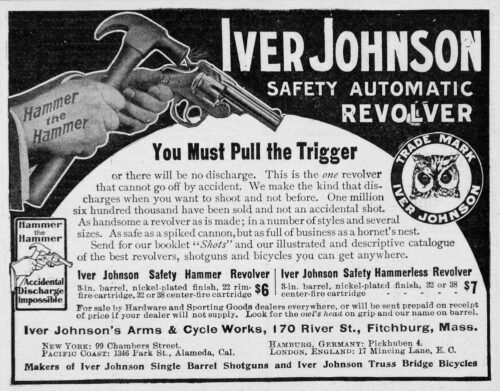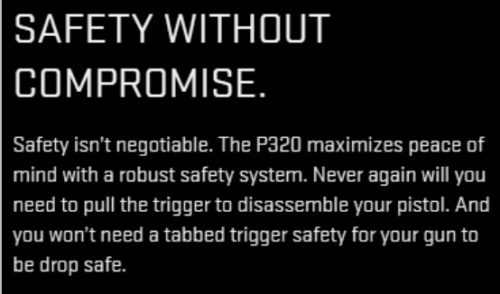
An old saw in America is that gun manufacturers are never to blame for anything, ever. Usually it’s phrased cynically as “guns don’t kill people”.
However, a growing number of highly trained and proficient shooters in America (e.g. the police) have been challenging that idea with… lawsuits blaming a gun manufacturer for people being shot by its guns.
The lawsuit comes after the Milwaukee Police Department reported on Sept. 10 that an officer’s holstered gun fired “inadvertently” as he searched a vehicle and injured another officer nearby. It’s the third time since July 2020 that a Milwaukee police officer’s gun fired without the trigger being pulled, according to Andrew Wagner, president of the Milwaukee Police Association. And it’s not the first time safety concerns have been raised about the model of firearm in question — the Sig Sauer P320. […] At least 22 lawsuits have been filed against Sig Sauer since 2018 alleging the P320 fired without anyone pulling the trigger. The lawsuits originate from Missouri, Massachusetts, Kentucky, Georgia and elsewhere. Eighteen have been filed since 2020.
It’s so bad, apparently, that even polite Canadians aren’t mincing words about the gun being at fault.
It recently became the official sidearm of Canada’s elite military unit, Joint Task Force 2, that is until one of the new guns fired on its own and shot a soldier…
“One of the new guns fired on its own” report coming from the Joint Task Force 2 certainly throws cold water on a “guns don’t kill people” theory.
The next twist to this story is that a judge very recently ruled in favor of the gun maker, using a rather technical and stupid premise.
…there was no evidence introduced at trial to show that SIG Sauer was aware of the Roscommon incident at the relevant time: in December 2016, when Guay purchased his P320 in reliance upon the advertisement. The evidence only established that SIG Sauer had seen the Roscommon video by January 10, 2019, more than three years after Guay purchased his gun.” In his lawsuit, Guay — who said he has “substantial firearms experience” — claims he was taking off his SIG Sauer holster with his SIG P320 secured in it on Jan. 28, 2020, “when the pistol fired and hit him in the right thigh without him ever touching the trigger. The hollow point bullet it discharged left a gaping wound…”
The last sentence brings up a small point (pun intended). Proponents of a hollow point bullet call for maximum possible damage, as if every round must be lethal. This expectation to cause extreme suffering was probably NOT meant for those being shot by their own P320 still in their holster. In context of predictable self-harm a hollow point seems rather… unnecessary and unwise.
A far bigger point obviously is that this unfortunate incident was in 2020, and the victim proved Sig Sauer was well aware of the problem since at least 2019. The court used a technicality to rule instead the victim couldn’t prove Sig Sauer knew about this problem way back in 2016 when he purchased the gun. Despite him not providing this evidence, it seems to be trivial to find.
What was the judge thinking?
The case somehow fixated on whether Sig Sauer knew about just one incident in particular at a very particular time. It reads like a very unintelligent and narrow burden, given what that case was really about.
Sig Sauer clearly knew at least since mid 2016 of Roscommon-like incidents given broad “class action” announcements in the news such as this one.
A prominent Kansas City plaintiffs attorney seeks class-action status for a lawsuit claiming that a Sig Sauer Inc. pistol has a defective design that creates a potentially lethal safety issue because it can fire when dropped. […] Sig Sauer already faces several other lawsuits related to premature discharge, including one by a sheriff’s deputy in Virginia, who claims her fully holstered Sig Sauer P320 discharged a bullet into her leg, even though she never touched the trigger. In addition, a lawsuit in Connecticut alleges that a police officer was shot [January 2017] when his P320 pistol fell as he loaded equipment into a vehicle. The pistol discharged when it hit the ground, and he was shot in the leg and knee.
Sig Sauer allegedly was knowingly misleading people with false advertising about safety in mid 2016, which many lawsuits seem to confirm repeatedly.
So again, what was the judge thinking?
Her ruling in 2022 that the plaintiff/victim couldn’t prove Sig Sauer was aware ten months later about a serious failure seems overly pedantic and disconnected from any reality of product safety.
Even though the Roscommon incident occurred in February 2016, there was no evidence that SIG Sauer became aware of the incident (or saw the video) close in time to the incident,” writes McCafferty in her ruling. …evidence at trial did not establish the date on which SIG Sauer first became aware of the incident, McCafferty writes.
Does this judge really want us all to believe that it’s up in the air whether Sig Sauer knew in 2016 their gun had shot a police officer?
I mean come on, here’s the 2021 Collette lawsuit text.
In February 2017, Sig Sauer sent an employee to Roscommon, Michigan, to investigate a possible defective discharge.
They knew. They knew in 2016.
In another 2021 very high-profile lawsuit, Sig Sauer gets called out for sticking their head in the sand for five years (e.g. since 2016) — very aware their marketing was false.
“Gun owners don’t want to think that their gun can just go off without the trigger being pulled. I picked up my bag, my keys were on top,” she said. “As I walked around my desk, my purse swings out and it shoots out the bottom of my bag.” […] Hilton’s $15 million lawsuit said, “there have been 54 reported uncommanded discharges of the P320,” meaning the gun went off by itself, over the last five years in 22 states and Washington, D.C.. […] “It’s not credible to claim that people with this amount of training, this amount of skill are all shooting themselves,” Bagnell said. “These are experts. It’s happening all over the country. … you would have to conclude there’s a problem with the product, not with the people.”
The very controversial phrase “guns kill people” apparently becomes more palatable among gun advocates if you say “there’s a problem with the product, not with the people”.
Ok, so clearly Sig Sauer knew they had a “problem with the product” by December 2016 despite the judge ruling it wasn’t obvious enough to her.
But wait, it gets even worse.
While Sig Sauer has continued to dispute that there is anything wrong with the P320, the company offered what it called a “voluntary upgrade” in 2017, saying, “These upgrades will enhance the protection against unintended discharges if the pistol is dropped.”
The protection should have been designed better and also should have been mandatory. Asking for volunteers to upgrade while saying there’s no need to upgrade makes zero sense. Even more to the point such an expensive upgrade in 2017 couldn’t have been on the books if the manufacturer hadn’t known by that time about the serious safety defect.
It’s obviously mixed messaging from the gun maker.
In late 2017, SIG SAUER implemented an upgraded design of the P320 pistol to enhance the safety and performance of its P320 model pistol. […] The SIG SAUER P320 pistol continues to meet and exceed all industry safety standards, and it is safe to carry and use in both the pre- and post-upgrade versions…
They released an enhanced safety fix while “all U.S. safety standards” say this fix isn’t needed to enhance safety.
Weasel words.
Do you know what is actually meant when Sig says ALL safety standards? None.
…the firearms industry self-polices its products, establishing its own design standards and initiating its own voluntary recalls…
And if that’s not proof enough for the court system to step up here and hold the manufacturer liable, the U.S. Army ran the P320 through significant testing (e.g. acted as a federal safety regulator) and by mid-2016 reported a major defect — discharge without trigger pull. BEFORE DECEMBER.
A modified trigger mechanism was implemented only for military sales, sending allegedly known defective guns into the general market exactly like all these lawsuits have been saying.
During its internal testing on April 20, 2016, the U.S. Army discovered that the SIG P320 pistol would fire unintentionally on its own when dropped, which the Army deemed to be a “deficiency.” […] The U.S. Department of Defense traced this “deficiency” to an issue with the trigger and sear. Recognizing the dangerous nature of the defect, the Department of Defense required SIG to correct the issue before continuing with the M17 / M18 contract (which it did successfully)
The gun maker by 2017 also was quoted as saying the commercial P320 would get the 2016 Army fix yet that doesn’t seem to have happened.
The Army’s M17 pistols, which came out of the Modular Handgun System trials, already have these upgrades and SIG reiterated that they were always planning to roll them out in the commercial P320s soon as well. […] SIG showed us high-speed footage of both the current commercial P320 version and the upgraded trigger version impacting the concrete. The difference was night and day.
You’d think regulators would step in at some point here, especially given how judges seem confused.

Going back to that small point above about packing hollow point bullets, lobbyists have refused all and any “safety” regulations in order to keep gun manufacturers unrestricted from selling maximum harm as a feature.
In reality gun products are exempted from regulation under the Consumer Product Safety Commission (CPSC), no matter how stupid that sounds. Gun safety is meant to be an absolutely critical step prior to owning and operating one, yet there are absolutely no safety standards for gun products. None.
The Remington 700 bolt-action rifle, the company’s most popular product, has been reported to fire without the trigger being pulled, which has resulted in the deaths of two dozen people and injuries to at least 100 others. The incidents spurred more than 75 lawsuits. Remington executives were reportedly made aware of the defects by engineers, but according to CNBC, the company held off on replacing the faulty trigger because it feared such a design change might be viewed as “an admission of guilt.” …a judge in 1983 found Remington in contempt of court, calling the company’s secrecy a “flagrant disregard of the law” and “obstructive and offensive … to justice.” Even a significant jury verdict can’t convince a manufacturer to fix a malfunctioning weapon [and] …even though an estimated 7 million defective firearms were sold, only 2,327 gun owners have submitted claims to Remington. The company’s recall process stands in stark contrast to how the federal government recalls dangerous products. For instance, the CPSC can mandate a recall of toy guns or crossbows that malfunction even if only one complaint has been filed with the agency.

In conclusion, this is a much wider problem than just one manufacturer. But Sig is an especially toxic brand as it markets their product specifically on the premise “safety isn’t negotiable”, which presumably is meant to taunt regulators.

When their gun is repeatedly found to be unsafe in multiple complaints over multiple years Sig negotiates through settlements and court battles in an attempt to destroy any true standard of product safety.
The answer to this problem is obvious. Lawsuits and settlements aren’t even close to sufficient. Can you believe a lawsuit over the resale value for a used P320 (someone argued Sig’s poor product quality deflated profits in the $28bn gun market) was shot down by a judge?
Guns, especially those made by brands peddling “safety isn’t negotiable” as their message, need to go under federal safety regulation. The U.S. Army has already proven how well it works (for them).
The decision was a home job as my basketball coach used to say. New Hampshire company New Hampshire judge. The trial evidence was that Sig admitted knowledge of uncommanded discharges as of August 2017 and in fact much earlier. Judge totally ignores it. Disgraceful.